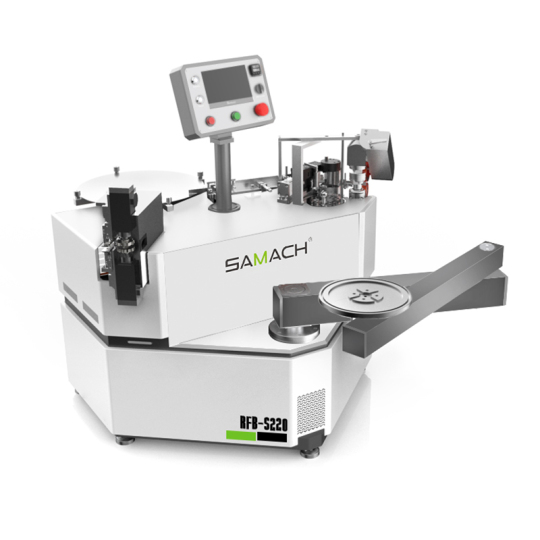{Edge Banding Machine: The Complete Buyer’s & Operator’s Guide

## Why the Edge Banding Machine Still Matters in 2025
In today’s cabinet and furniture workflows, the Edge Banding Machine is central to premium edge finishes using PVC/ABS/veneer/melamine tapes.
From custom shops to industrial lines, the right edgebander improves aesthetics and lowers costs.
## What Is an Edge Banding Machine?
An Edge Banding Machine applies a narrow strip of material to raw panel edges and then polishes it for a seamless look.
Key steps: pre-mill, adhere tape, press with rollers, trim ends, profile, and polish.
## Edge Banding Process: Step by Step
1. In-feed & Alignment — A guided in-feed keeps parts straight and stable.
2. Pre-milling — Remove 0.3–1.0 mm to eliminate saw chatter and out-of-square conditions.
3. Glue — Thin, consistent glue lines improve durability.
4. Feed & Pressure — Primary/secondary rollers press the tape.
5. End Cut — Clean ends define the part geometry.
6. Flush Trimming — Trim excess flush to panel faces.
7. Corner Processing — Improves safety and aesthetics.
8. Scraping & Buffing — Ready-for-install finish.
## Choosing a Machine Class
• Manual/Portable — compact and cheap, best for repairs; quality depends on skill.
• Entry Automatic — stable quality at modest volume; core trimming features included.
• Mid-Tier — better finish (pre-mill + corner round), faster changeovers, lower rework.
• Industrial/High-End — zero-joint (hot-air/laser), servo stations, high feed speed, line integration.
• Contour/Curve — for irregular parts; often needs special tapes or adhesives.
## EVA vs PUR vs Zero-Joint
• EVA Hot-Melt — affordable and easy to clean, but lower heat/moisture resistance and more visible glue lines on dark colors.
• PUR — ideal for high-end or humid environments; higher cost, tighter process.
• Zero-Joint — no liquid glue pot; perfect aesthetics with matched functional layers.
Tip: Stock EVA + PUR if your machine supports quick glue-pot this site swaps.
## What to Look For in a Machine
• Feed speed (~8–23 m/min) — higher speed raises throughput; match upstream CNC capacity.
• Thickness range — ensure it fits your product mix.
• Tape thickness — 0.4–1 mm (lightweight) vs 2–3 mm (robust edges).
• Edge prep — invest here for visible quality gains.
• Corners — important for doors/drawer fronts.
• Finish stations — remove micro-lip and polish.
• Glue tech — drives TCO, appearance, and process control.
• Controls/recipes — touchscreen, memory speeds changeovers and consistency.
• Dust — don’t skimp on airflow.
• Switchover — faster changes, higher OEE.
• Power/footprint — match facility voltage/phase/air and layout.
## Best-Fit Recommendations
• Custom shops — choose pre-mill + PUR, rounding, smart controls.
• Commercial millwork/furniture — industrial model with servo stations, high speed, auto setups, in-line QC.
• Showpiece finishes — invest in zero-joint.
• High volume — thick tape support + conveyors.
• Starter — simple, reliable, budget-friendly.
## Daily Habits That Pay Off
• Stabilize environment; verify three-phase power, air, and dust extraction.
• Avoid over-cutting; minimal removal preserves time and material.
• Adhesive discipline prevents defects.
• Right pressure equals tight, clean seams.
• Watch finish to time tool changes.
• Good cleaning protects finish and uptime.
• Culture of safety = fewer surprises.
## Diagnose & Correct Fast
• Visible glue line — raise temp within spec, add pressure, verify pre-mill; consider PUR/zero-joint for dark/gloss.
• Corner peel — refine rounding, ensure activation/press time, clean surfaces.
• Veneer fuzz — sharp tools and gentler passes.
• Excess glue — tune gap/pressure.
• Tracking off — align fences and tape feed.
## Materials & Tape Choices
PVC/ABS are industry staples with broad décor ranges; veneer looks premium but needs sharp tooling; melamine is budget friendly; aluminum/acrylic are specialty options requiring slower feeds.
For zero-joint, ensure tapes include a compatible functional layer and that its color aligns with the panel.
## Boosting Throughput with Integration
Connect your edgebander with nesting CNC, return conveyors, automated in/out-feed, and MES/ERP for live QA.
## Greener Edge Banding Choices
PUR/zero-joint can extend service life, low-VOC adhesives and effective dust extraction improve indoor air, and recycled-content tapes or responsible veneer meet green specs.
## Edge Banding Machine FAQs
Ideal feed speed? Start with OEM recommendations, then tune for adhesive and tape thickness.
EVA vs PUR? EVA is easier to clean; PUR bonds stronger with a thinner line.
Pre-milling? Improves adhesion.
Zero-joint? Premium appeal.
Tool life? Watch for more scraping marks; then replace.
## Bottom Line
An Edge Banding Machine is more than a finisher. Pair the right adhesive system to speed changeovers. }